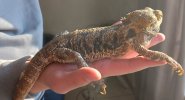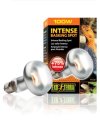TheLastGreen
Well-Known Member
My brother, Gerhard, has a beardy named Velkor. He's 7 years old, around 30 cm from head to tail.
Recently Velkor's gotten really inactive, for 3 days he's been on the same spot. Velkors' neck twitches above his right scapula. I'm afraid to say from what we see now, it seems Gerhard's gotten the wrong info from the start, just like in the tort hobby.
His enclosure is about 0,75m², and has a spiral and red heat lamp. He's also got a heatpad.
The substrate is paper towels.
Velkor has a water bowl and a little food bowl. Gerhard feeds him little bearded dragon pellets, butternut, a little piece of apple rarely and some cut up cucumber. A while back he had crickets, Velkor is also offered bellpeppers and brocolli, but Velkor shows no interest in them.
Velkor pooped a week ago.
My brother also wants to know if he's claws are too long? His beardy has a habit of folding his hands inward when he sits, could this be a sign of something?
His beardy has a habit of folding his hands inward when he sits, could this be a sign of something?

Recently Velkor's gotten really inactive, for 3 days he's been on the same spot. Velkors' neck twitches above his right scapula. I'm afraid to say from what we see now, it seems Gerhard's gotten the wrong info from the start, just like in the tort hobby.
His enclosure is about 0,75m², and has a spiral and red heat lamp. He's also got a heatpad.
The substrate is paper towels.
Velkor has a water bowl and a little food bowl. Gerhard feeds him little bearded dragon pellets, butternut, a little piece of apple rarely and some cut up cucumber. A while back he had crickets, Velkor is also offered bellpeppers and brocolli, but Velkor shows no interest in them.
Velkor pooped a week ago.
My brother also wants to know if he's claws are too long?
 His beardy has a habit of folding his hands inward when he sits, could this be a sign of something?
His beardy has a habit of folding his hands inward when he sits, could this be a sign of something?
Last edited:
